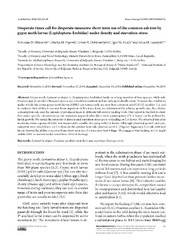Приказ основних података о документу
Desperate times call for desperate measures: Short-term use of the common ash tree by gypsy moth larvae (Lepidoptera: Erebidae) under density and starvation stress
| dc.creator | Milanović, Slobodan | |
| dc.creator | Popović, Marija | |
| dc.creator | Dobrosavljević, Jovan | |
| dc.creator | Kostić, Igor | |
| dc.creator | Lazarević, Jelica | |
| dc.date.accessioned | 2020-04-29T12:19:29Z | |
| dc.date.available | 2020-04-29T12:19:29Z | |
| dc.date.issued | 2020 | |
| dc.identifier.issn | 0354-4664 | |
| dc.identifier.uri | http://www.serbiosoc.org.rs/arch/index.php/abs/article/view/4780 | |
| dc.identifier.uri | https://radar.ibiss.bg.ac.rs/handle/123456789/3653 | |
| dc.description.abstract | Gypsy moth, Lymantria dispar L. (Lepidoptera: Erebidae) feeds on a large number of tree species, while ash, Fraxinus spp. (Lamiales: Oleaceae) species are considered resistant and are only sporadically eaten. To assess the conditions under which late instar gypsy moth larvae (GML) can temporarily use non-host common ash (CA) (F. excelsior L.), and to evaluate their ability to recover from ingestion of this toxic food, we determined the relative growth rate, the relative consumption rate and the amount of produced feces in different laboratory feeding trials. Our report is the first to show that under specific circumstances, the resources acquired after short-term consumption of CA leaves can be utilized for larval growth. We varied the intensity of density and starvation stress prior to feeding on CA leaves. We observed that after moderate stress a group of GML was temporarily capable of coping with CA leaves. Although observed growth and consumption were much lower on CA than on the optimal host oak, Quercus cerris L. (Fagales: Fagaceae), CA-oak-switched larvae showed the ability to recover from short-term use of a toxic non-host foliage. This suggests that feeding on CA might enable GML to survive under conditions of food shortage. | en |
| dc.relation | info:eu-repo/grantAgreement/MESTD/Integrated and Interdisciplinary Research (IIR or III)/43007/RS// | |
| dc.rights | openAccess | |
| dc.rights.uri | https://creativecommons.org/licenses/by-nc-nd/4.0/ | |
| dc.source | Archives of Biological Sciences | |
| dc.subject | Lymantria dispar | |
| dc.subject | Fraxinus excelsior | |
| dc.subject | Non-host use | |
| dc.subject | Recovery | |
| dc.subject | Quercus cerris | |
| dc.title | Desperate times call for desperate measures: Short-term use of the common ash tree by gypsy moth larvae (Lepidoptera: Erebidae) under density and starvation stress | en |
| dc.type | article | en |
| dc.rights.license | BY-NC-ND | |
| dcterms.abstract | Поповић, Марија; Добросављевић, Јован; Милановић, Слободан; Костић, Игор; Лазаревић, Јелица; | |
| dc.rights.holder | © 2020 by the Serbian Biological Society. | |
| dc.citation.issue | 1 | |
| dc.citation.volume | 72 | |
| dc.identifier.doi | 10.2298/abs191106067m | |
| dc.identifier.scopus | 2-s2.0-85084264990 | |
| dc.identifier.wos | 000524505000008 | |
| dc.citation.apa | Milanović, S., Popović, M., Dobrosavljević, J., Kostić, I., & Lazarević, J. (2020). Desperate times call for desperate measures: Short-term use of the common ash tree by gypsy moth larvae (Lepidoptera: Erebidae) under density and starvation stress. Archives of Biological Sciences, 72(1), 63–69. | |
| dc.citation.vancouver | Milanović S, Popović M, Dobrosavljević J, Kostić I, Lazarević J. Desperate times call for desperate measures: Short-term use of the common ash tree by gypsy moth larvae (Lepidoptera: Erebidae) under density and starvation stress. Arch Biol Sci. 2020;72(1):63–9. | |
| dc.citation.spage | 63 | |
| dc.citation.epage | 69 | |
| dc.type.version | publishedVersion | |
| dc.identifier.fulltext | https://radar.ibiss.bg.ac.rs/bitstream/id/6130/ABS-72-1-063-069.pdf | |
| dc.citation.rank | M23 |

